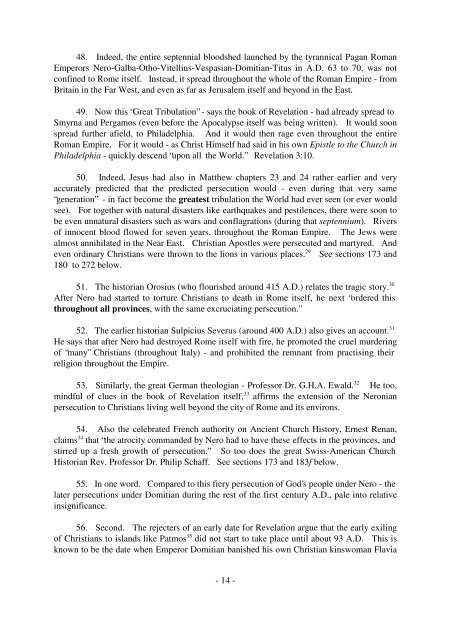JERUSALEM; ROME; REVELATION - The Preterist Archive
JERUSALEM; ROME; REVELATION - The Preterist Archive
JERUSALEM; ROME; REVELATION - The Preterist Archive
You also want an ePaper? Increase the reach of your titles
YUMPU automatically turns print PDFs into web optimized ePapers that Google loves.
48. Indeed, the entire septennial bloodshed launched by the tyrannical Pagan Roman<br />
Emperors Nero-Galba-Otho-Vitellius-Vespasian-Domitian-Titus in A.D. 63 to 70, was not<br />
confined to Rome itself. Instead, it spread throughout the whole of the Roman Empire - from<br />
Britain in the Far West, and even as far as Jerusalem itself and beyond in the East.<br />
49. Now this “Great Tribulation” - says the book of Revelation - had already spread to<br />
Smyrna and Pergamos (even before the Apocalypse itself was being written). It would soon<br />
spread further afield, to Philadelphia. And it would then rage even throughout the entire<br />
Roman Empire. For it would - as Christ Himself had said in his own Epistle to the Church in<br />
Philadelphia - quickly descend “upon all the World.” Revelation 3:10.<br />
50. Indeed, Jesus had also in Matthew chapters 23 and 24 rather earlier and very<br />
accurately predicted that the predicted persecution would - even during that very same<br />
“generation” - in fact become the greatest tribulation the World had ever seen (or ever would<br />
see). For together with natural disasters like earthquakes and pestilences, there were soon to<br />
be even unnatural disasters such as wars and conflagrations (during that septennium). Rivers<br />
of innocent blood flowed for seven years, throughout the Roman Empire. <strong>The</strong> Jews were<br />
almost annihilated in the Near East. Christian Apostles were persecuted and martyred. And<br />
even ordinary Christians were thrown to the lions in various places. 29 See sections 173 and<br />
180 to 272 below.<br />
51. <strong>The</strong> historian Orosius (who flourished around 415 A.D.) relates the tragic story. 30<br />
After Nero had started to torture Christians to death in Rome itself, he next “ordered this<br />
throughout all provinces, with the same excruciating persecution.”<br />
52. <strong>The</strong> earlier historian Sulpicius Severus (around 400 A.D.) also gives an account. 31<br />
He says that after Nero had destroyed Rome itself with fire, he promoted the cruel murdering<br />
of “many” Christians (throughout Italy) - and prohibited the remnant from practising their<br />
religion throughout the Empire.<br />
53. Similarly, the great German theologian - Professor Dr. G.H.A. Ewald. 32 He too,<br />
mindful of clues in the book of Revelation itself, 33 affirms the extension of the Neronian<br />
persecution to Christians living well beyond the city of Rome and its environs.<br />
54. Also the celebrated French authority on Ancient Church History, Ernest Renan,<br />
claims 34 that “the atrocity commanded by Nero had to have these effects in the provinces, and<br />
stirred up a fresh growth of persecution.” So too does the great Swiss-American Church<br />
Historian Rev. Professor Dr. Philip Schaff. See sections 173 and 183f below.<br />
55. In one word. Compared to this fiery persecution of God’s people under Nero - the<br />
later persecutions under Domitian during the rest of the first century A.D., pale into relative<br />
insignificance.<br />
56. Second. <strong>The</strong> rejecters of an early date for Revelation argue that the early exiling<br />
of Christians to islands like Patmos 35 did not start to take place until about 93 A.D. This is<br />
known to be the date when Emperor Domitian banished his own Christian kinswoman Flavia<br />
- 14 -
















